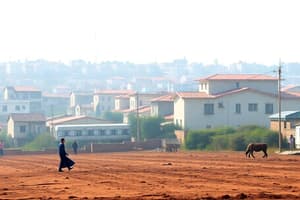Podcast
Questions and Answers
In some countries, the ______ expectancy has increased due to better medicines.
In some countries, the ______ expectancy has increased due to better medicines.
life
Diseases like malaria and HIV affect the ______ expectancy in less developed countries.
Diseases like malaria and HIV affect the ______ expectancy in less developed countries.
life
The ______ rate is the number of deaths per 1000 population in a year.
The ______ rate is the number of deaths per 1000 population in a year.
death
The ______ rate is the number of births per 1000 population in a year.
The ______ rate is the number of births per 1000 population in a year.
Population growth is the increase in a country's population during a year, expressed as a percentage of the ______.
Population growth is the increase in a country's population during a year, expressed as a percentage of the ______.
Study Notes
Demographic Transition Model
- The model shows the change from high birth rate and death rate to low birth rate and death rate over time
- Typical of less developed countries: high proportion of children, high death rate, and short life expectancy
- Factors contributing to high birth rate and death rate: lack of access to birth control and healthcare, limited knowledge about preventing or curing diseases, and poor sanitation and hygiene
Stages of the Demographic Transition Model
- Stage 1: High birth rate and death rate, typical of less developed countries
- Stage 2: Shrinking population pyramid, lower numbers of younger people, more ageing people, and long life expectancy, typical of very developed countries
Differences in Development Around the World
- More Economically Developed Countries (MEDCs) have higher literacy levels and lower infant mortality rates
- Social measures: life expectancy, death rate, infant mortality rate, percentage of population undernourished, and percentage of country's budget spent on healthcare
Environmental Indicators
- Measure the extent of human impact on the environment
- Examples: percentage of polluting gases in the atmosphere, quality of water, and drop in fish stocks in the sea
Human Development Index (HDI)
- Adopted in 2010 as a more reliable indicator than GDP
- Takes three indicators into account: life expectancy, adult literacy, and GDP
- Does not consider environmental factors
- Ranks 187 countries, with Norway, Australia, and Switzerland being the top three in 2014
Population Characteristics and Development
- Population growth: increase in a country's population during a year, expressed as a percentage of the population
- Calculated as the difference between birth rate and death rate
- Birth rate: number of births per 1000 population in a year
- Death rate: number of deaths per 1000 population in a year
Studying That Suits You
Use AI to generate personalized quizzes and flashcards to suit your learning preferences.
Description
Test your knowledge on the demographic transition model, which shows the change from high birth rate and death rate to low birth rate and death rate over time. Understand the stages of this model and how it applies to developed and less developed countries.



